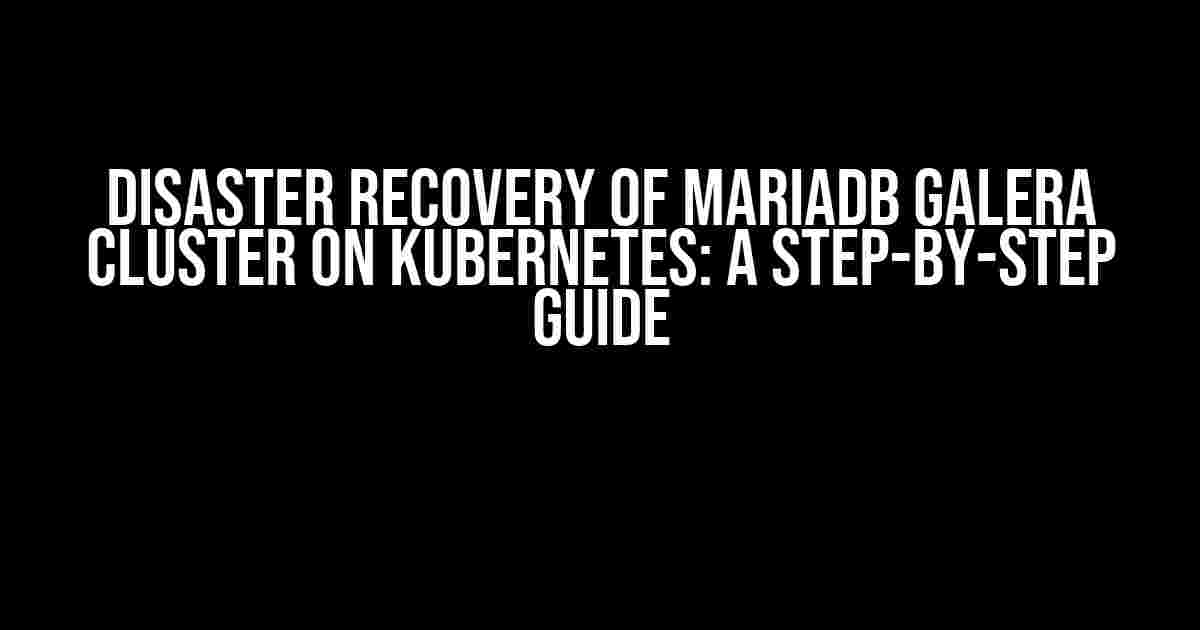Are you tired of losing sleep over the thought of your MariaDB Galera cluster going down? Do you want to ensure that your Kubernetes-based application can survive even the most catastrophic disasters? Look no further! In this comprehensive guide, we’ll take you through the process of setting up disaster recovery for your MariaDB Galera cluster on Kubernetes, so you can rest easy knowing your data is safe and your application is always available.
- What is Disaster Recovery?
- Why Do I Need Disaster Recovery for My MariaDB Galera Cluster on Kubernetes?
- Preparation is Key: Understanding Your Cluster and Kubernetes Environment
- Disaster Recovery Strategies for MariaDB Galera Cluster on Kubernetes
- Implementing Disaster Recovery for MariaDB Galera Cluster on Kubernetes
- Best Practices for Disaster Recovery of MariaDB Galera Cluster on Kubernetes
- Conclusion
What is Disaster Recovery?
Disaster recovery refers to the process of restoring your application and data after a disaster, such as a hardware failure, software corruption, or natural disaster. It’s an essential component of any business continuity plan, as it ensures that your application can recover quickly and efficiently in the event of an outage.
Why Do I Need Disaster Recovery for My MariaDB Galera Cluster on Kubernetes?
MariaDB Galera cluster provides high availability and scalability for your database, but it’s not immune to disasters. Kubernetes, as a container orchestration platform, can also experience outages. Without a disaster recovery plan, you risk losing access to your data and application, which can result in financial losses, damage to your reputation, and a loss of customer trust.
Preparation is Key: Understanding Your Cluster and Kubernetes Environment
Before we dive into the disaster recovery process, it’s essential to understand your MariaDB Galera cluster and Kubernetes environment. Take the time to review your current setup and make note of the following:
-
Cluster topology: Identify the nodes in your cluster, their roles, and the network topology.
-
Kubernetes infrastructure: Understand the Kubernetes components, such as the API server, controller manager, and etcd.
-
Storage: Identify the storage solutions used for your database and application data.
-
Backup and restore procedures: Review your current backup and restore processes, including the tools and scripts used.
Disaster Recovery Strategies for MariaDB Galera Cluster on Kubernetes
There are several disaster recovery strategies you can implement for your MariaDB Galera cluster on Kubernetes. The choice of strategy depends on your business requirements, infrastructure, and resources. Here are some common strategies:
1. Backup and Restore
Backup and restore is the most basic disaster recovery strategy. It involves taking regular backups of your database and application data, which can be restored in the event of a disaster.
mysqldump -u root -p${MYSQL_PASSWORD} --single-transaction --triggers --routines --events --all-databases > backup.sql
2. Clone and Swap
The clone and swap strategy involves creating a duplicate of your cluster and swapping it with the primary cluster in the event of a disaster.
kubectl create deployment dr-cluster --image mariadb:10.5
3. Auto-pilot Disaster Recovery
Auto-pilot disaster recovery uses automation tools, such as Ansible or Terraform, to detect disasters and automatically recover your cluster.
ansible-playbook -i inventory.ini dr-playbook.yml
Implementing Disaster Recovery for MariaDB Galera Cluster on Kubernetes
Now that we’ve covered the disaster recovery strategies, let’s implement a comprehensive disaster recovery plan for your MariaDB Galera cluster on Kubernetes.
Step 1: Create a Backup and Restore Process
Create a script to take regular backups of your database and application data. You can use tools like mysqldump, mariabackup, or Percona XtraBackup.
#!/bin/bash
# Set backup directory
BACKUP_DIR=/backup
# Set database credentials
MYSQL_USER=root
MYSQL_PASSWORD= password
# Take backup
mysqldump -u ${MYSQL_USER} -p${MYSQL_PASSWORD} --single-transaction --triggers --routines --events --all-databases > ${BACKUP_DIR}/backup.sql
# Compress backup
gzip ${BACKUP_DIR}/backup.sql
Step 2: Create a Duplicate Cluster
Create a duplicate of your MariaDB Galera cluster using Kubernetes deployments and persistent volumes.
apiVersion: apps/v1
kind: Deployment
metadata:
name: dr-cluster
spec:
replicas: 3
selector:
matchLabels:
app: mariadb
template:
metadata:
labels:
app: mariadb
spec:
containers:
- name: mariadb
image: mariadb:10.5
volumeMounts:
- name: data
mountPath: /var/lib/mysql
volumes:
- name: data
persistentVolumeClaim:
claimName: mariadb-pvc
Step 3: Configure Auto-pilot Disaster Recovery
Use automation tools, such as Ansible or Terraform, to detect disasters and automatically recover your cluster.
---
- name: DR automation
hosts: localhost
gather_facts: no
tasks:
- name: Check cluster status
shell: kubectl get deployments | grep dr-cluster
register: cluster_status
- name: Recover cluster
shell: ansible-playbook -i inventory.ini dr-playbook.yml
when: cluster_status.stdout == ""
Best Practices for Disaster Recovery of MariaDB Galera Cluster on Kubernetes
To ensure that your disaster recovery plan is effective, follow these best practices:
-
Regularly test your disaster recovery plan to ensure it works as expected.
-
Use redundant storage solutions to ensure data availability.
-
Implement role-based access control to restrict access to your cluster and data.
-
Use encryption to protect your data in transit and at rest.
-
Monitor your cluster and application performance to detect potential issues before they become disasters.
Conclusion
Disaster recovery is an essential component of any business continuity plan. By following the steps and strategies outlined in this guide, you can ensure that your MariaDB Galera cluster on Kubernetes is protected from disasters and can recover quickly and efficiently in the event of an outage. Remember to regularly test and update your disaster recovery plan to ensure it remains effective and efficient.
| Disaster Recovery Strategy | Description |
|---|---|
| Backup and Restore | Takes regular backups of database and application data, which can be restored in the event of a disaster. |
| Clone and Swap | Creates a duplicate of the cluster and swaps it with the primary cluster in the event of a disaster. |
| Auto-pilot Disaster Recovery | Uses automation tools to detect disasters and automatically recover the cluster. |
By implementing a comprehensive disaster recovery plan, you can ensure business continuity, protect your data, and maintain customer trust. Don’t wait until it’s too late – start planning your disaster recovery strategy today!
Frequently Asked Question
Get the answers to your most pressing questions about disaster recovery of MariaDB Galera Cluster on Kubernetes!
Q1: What is the importance of disaster recovery in a MariaDB Galera Cluster on Kubernetes?
Disaster recovery is crucial in a MariaDB Galera Cluster on Kubernetes because it ensures high availability and data integrity in the event of a disaster or system failure. With a Galera Cluster, data is replicated across multiple nodes, but if a disaster strikes, you need a plan to recover and restore your database to minimize downtime and data loss.
Q2: How does Kubernetes play a role in disaster recovery of a MariaDB Galera Cluster?
Kubernetes provides a scalable and resilient infrastructure for running a MariaDB Galera Cluster, allowing you to easily spin up new nodes and deploy containers in response to failures or disasters. Additionally, Kubernetes provides features like Persistent Volumes (PVs) and StatefulSets, which help ensure data persistence and simplify the recovery process.
Q3: What are some common disaster recovery scenarios for a MariaDB Galera Cluster on Kubernetes?
Common disaster recovery scenarios include node failures, network partitions, database corruptions, and even entire data center outages. With a well-planned disaster recovery strategy, you can ensure that your MariaDB Galera Cluster on Kubernetes can withstand these scenarios and minimize downtime and data loss.
Q4: How can I test my disaster recovery plan for a MariaDB Galera Cluster on Kubernetes?
Testing your disaster recovery plan is crucial to ensure its effectiveness. You can use Kubernetes’ built-in features, such as kubectl, to simulate failures and test your recovery process. Additionally, you can use tools like Galera Cluster’s built-in testing frameworks and Kubernetes’ Chaos Engineering tools to simulate real-world disaster scenarios.
Q5: What are some best practices for implementing disaster recovery in a MariaDB Galera Cluster on Kubernetes?
Some best practices for implementing disaster recovery include designing a highly available architecture, implementing regular backups and snapshots, using automated failover and recovery tools, and regularly testing and validating your disaster recovery plan to ensure its effectiveness in real-world scenarios.



